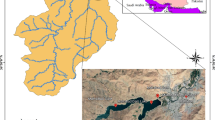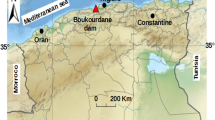Abstract
Evaporation is a crucial factor in hydrological studies; its precise measurement has always been challenging due to the costly recording tolls. Therefore, machine learning models that can give reliable predictive results with the least information available have been recommended for evaporation prediction. This study was conducted in the central of Iran using the data related to the Doroudzan dam. Several hydrological and meteorological variables, including inflow and outflow of the reservoir, lake area behind the dam, temperature, overflow from the reservoir, precipitation, and evaporation at the previous month, were considered input data to predict the evaporation at the current month. Monthly data from October 1999 to September 2020 were used during the modeling. First, the single adaptive neuro-fuzzy inference system (ANFIS) and least-squares support vector regression (LS-SVR) models were evaluated for predicting the amount of evaporation using different scenarios defined based on the different combinations of input variables. The results showed that LS-SVR with RMSE = 2.77, MAPE = 2.48, and NSE = 0.93 provided a better prediction than ANFIS. Second, the Harris hawks optimization (HHO) algorithm was used to optimize the parameters of ANFIS to check for the possibility of performance improvement. The hybrid ANFIS-HHO model predicted the evaporation with RMSE = 2.35, MAPE = 1.55, and NSE = 0.95, respectively. The Taylor’s diagram also demonstrated the superior performance of the hybrid ANFIS-HHO model than the LS-SVR and ANFIS models. The best scenario for all three models included all input variables but the area behind the dam into the models. The methodology proposed in this study is useful for predicting the evaporation from dam reservoirs under the influence of various dam variables.





Similar content being viewed by others
Availability of data and materials
Not applicable.
References
Adnan, R. M., Jaafari, A., Mohanavelu, A., Kisi, O., & Elbeltagi, A. (2021). Novel ensemble forecasting of streamflow using locally weighted learning algorithm. Sustainability, 13(11), 5877.
Allawi, M. F., Aidan, I. A., & El-Shafie, A. (2021). Enhancing the performance of data-driven models for monthly reservoir evaporation prediction. Environmental Science and Pollution Research, 28(7), 8281–8295.
Allawi, M. F., Binti Othman, F., Afan, H. A., Ahmed, A. N., Hossain, M., Fai, C. M., & El-Shafie, A. (2019). Reservoir evaporation prediction modeling based on artificial intelligence methods. Water, 11(6), 1226.
Antonopoulos, V. Z., & Antonopoulos, A. V. (2017). Daily reference evapotranspiration estimates by artificial neural networks technique and empirical equations using limited input climate variables. Computers and Electronics in Agriculture, 132, 86–96.
Arya Azar, N., Milan, S. G., & Kayhomayoon, Z. (2021). The prediction of longitudinal dispersion coefficient in natural streams using LS-SVM and ANFIS optimized by Harris hawk optimization algorithm. Journal of Contaminant Hydrology, 240, 103781.
Asefpour Vakilian, K., & Massah, J. (2018). A fuzzy-based decision making software for enzymatic electrochemical nitrate biosensors. Chemometrics and Intelligent Laboratory Systems, 177, 55–63.
Bemani, A., Baghban, A., Shamshirband, S., Mosavi, A., Csiba, P., & Várkonyi-Kóczy, A. R. (2019). Applying ANN, ANFIS, and LSSVM models for estimation of acid solvent solubility in supercritical CO $ _2$. arXiv preprint arXiv:1912.05612.
Benzaghta, M. A., Mohammed, T. A., Ghazali, A. H., & Soom, M. A. M. (2012). Prediction of evaporation in tropical climate using artificial neural network and climate based models. Scientific Research and Essays, 7(36), 3133–3148.
Bo, W., Fang, Z. B., Wei, L. X., Cheng, Z. F., & Hua, Z. X. (2021). Malicious URLs detection based on a novel optimization algorithm. IEICE TRANSACTIONS on Information and Systems, 104(4), 513–516.
Chen, Y., He, L., Li, J., & Zhang, S. (2018). Multi-criteria design of shale-gas-water supply chains and production systems towards optimal life cycle economics and greenhouse gas emissions under uncertainty. Computers & Chemical Engineering, 109, 216–235.
Chu, H. J., & Chang, L. C. (2009). Application of optimal control and fuzzy theory for dynamic groundwater remediation design. Water Resources Management, 23(4), 647–660.
Friedrich, K., Grossman, R. L., Huntington, J., Blanken, P. D., Lenters, J., Holman, K. D., & Healey, N. C. (2018). Reservoir evaporation in the Western United States: Current science, challenges, and future needs. Bulletin of the American Meteorological Society, 99(1), 167–187.
Ghorbani, M. A., Deo, R. C., Yaseen, Z. M., Kashani, M. H., & Mohammadi, B. (2018). Pan evaporation prediction using a hybrid multilayer perceptron-firefly algorithm (MLP-FFA) model: Case study in North Iran. Theoretical and Applied Climatology, 133(3–4), 1119–1131.
Goyal, M. K., Bharti, B., Quilty, J., Adamowski, J., & Pandey, A. (2014). Modeling of daily pan evaporation in sub tropical climates using ANN, LS-SVR, fuzzy logic, and ANFIS. Expert Systems with Applications, 41(11), 5267–5276.
He, L., Chen, Y., & Li, J. (2018). A three-level framework for balancing the tradeoffs among the energy, water, and air-emission implications within the life-cycle shale gas supply chains. Resources, Conservation and Recycling, 133, 206–228.
He, Y., Dai, L., & Zhang, H. (2020). Multi-branch deep residual learning for clustering and beamforming in user-centric network. IEEE Communications Letters, 24(10), 2221–2225.
Heidari, A. A., Mirjalili, S., Faris, H., Aljarah, I., Mafarja, M., & Chen, H. (2019). Harris hawks optimization: Algorithm and applications. Future Generation Computer Systems, 97, 849–872.
Hua, L., Zhu, H., Shi, K., Zhong, S., Tang, Y., & Liu, Y. (2021). Novel finite-time reliable control design for memristor-based inertial neural networks with mixed time-varying delays. IEEE Transactions on Circuits and Systems i: Regular Papers, 68(4), 1599–1609.
Jang, J-SR. (1993) ANFIS: adaptive-network-based fuzzy inference system. IEEE Transactions on Systems, Man, and Cybernetics, 23(3), 665–685.
Jiang, Q., Shao, F., Lin, W., Gu, K., Jiang, G., & Sun, H. (2017). Optimizing multistage discriminative dictionaries for blind image quality assessment. IEEE Transactions on Multimedia, 20(8), 2035–2048.
Keshtegar, B., Piri, J., & Kisi, O. (2016). A nonlinear mathematical modeling of daily pan evaporation based on conjugate gradient method. Computers and Electronics in Agriculture, 127, 120–130.
Kim, S., Shiri, J., Kisi, O., & Singh, V. P. (2013). Estimating daily pan evaporation using different data-driven methods and lag-time patterns. Water Resources Management, 27(7), 2267–2286.
Kişi, Ö. (2006). Daily pan evaporation modelling using a neuro-fuzzy computing technique. Journal of Hydrology, 329(3–4), 636–646.
Limjirakan, S., & Limsakul, A. (2012). Trends in Thailand pan evaporation from 1970 to 2007. Atmospheric Research, 108, 122–127.
Milan, S. G., Roozbahani, A., Arya Azar, N., & Javadi, S. (2021). Development of adaptive neuro fuzzy inference system–Evolutionary algorithms hybrid models (ANFIS-EA) for prediction of optimal groundwater exploitation. Journal of Hydrology, 598, 126258.
Nhu, V. H., Mohammadi, A., Shahabi, H., Shirzadi, A., Al-Ansari, N., Ahmad, B. B., & Nguyen, H. (2020). Monitoring and assessment of water level fluctuations of the Lake Urmia and its environmental consequences using multitemporal landsat 7 ETM+ images. International Journal of Environmental Research and Public Health, 17(12), 4210.
Orimoloye, I. R., Belle, J. A., Olusola, A. O., Busayo, E. T., & Ololade, O. O. (2021). Spatial assessment of drought disasters, vulnerability, severity and water shortages: A potential drought disaster mitigation strategy. Natural Hazards, 105(3), 2735–2754.
Orimoloye, I. R., Kalumba, A. M., Mazinyo, S. P., & Nel, W. (2020). Geospatial analysis of wetland dynamics: Wetland depletion and biodiversity conservation of Isimangaliso Wetland, South Africa. Journal of King Saud University-Science, 32(1), 90–96.
Owolabi, S. T., Madi, K., Kalumba, A. M., & Orimoloye, I. R. (2020). A groundwater potential zone mapping approach for semi-arid environments using remote sensing (RS), geographic information system (GIS), and analytical hierarchical process (AHP) techniques: A case study of Buffalo catchment, Eastern Cape. South Africa. Arabian Journal of Geosciences, 13(22), 1–17.
Quan, Q., Gao, S., Shang, Y., & Wang, B. (2021). Assessment of the sustainability of Gymnocypris eckloni habitat under river damming in the source region of the Yellow River. Science of The Total Environment, 778, 146312.
Quinn, R., Parker, A., & Rushton, K. (2018). Evaporation from bare soil: Lysimeter experiments in sand dams interpreted using conceptual and numerical models. Journal of Hydrology, 564, 909–915.
Razavi, R., Sabaghmoghadam, A., Bemani, A., Baghban, A., Chau, K. W., & Salwana, E. (2019). Application of ANFIS and LSSVM strategies for estimating thermal conductivity enhancement of metal and metal oxide based nanofluids. Engineering Applications of Computational Fluid Mechanics, 13(1), 560–578.
Rianna, G., Reder, A., & Pagano, L. (2018). Estimating actual and potential bare soil evaporation from silty pyroclastic soils: Towards improved landslide prediction. Journal of Hydrology, 562, 193–209.
Sebbar, A., Heddam, S., & Djemili, L. (2019). Predicting daily pan evaporation (E pan) from dam reservoirs in the Mediterranean regions of Algeria: OPELM vs OSELM. Environmental Processes, 6(1), 309–319.
Shehabeldeen, T. A., Abd Elaziz, M., Elsheikh, A. H., & Zhou, J. (2019). Modeling of friction stir welding process using adaptive neuro-fuzzy inference system integrated with Harris hawks optimizer. Journal of Materials Research and Technology, 8(6), 5882–5892.
Suykens, J. A., & Vandewalle, J. (1999). Least squares support vector machine classifiers. Neural Processing Letters, 9(3), 293–300.
Wang, Q., Wang, W., Zhong, Z., Wang, H., & Fu, Y. (2020). Variation in glomalin in soil profiles and its association with climatic conditions, shelterbelt characteristics, and soil properties in poplar shelterbelts of Northeast China. Journal of Forestry Research, 31(1), 279–290.
Weng, L., He, Y., Peng, J., Zheng, J., & Li, X. (2021). Deep cascading network architecture for robust automatic modulation classification. Neurocomputing, 455, 308–324.
Wu, L., Huang, G., Fan, J., Ma, X., Zhou, H., & Zeng, W. (2020). Hybrid extreme learning machine with meta-heuristic algorithms for monthly pan evaporation prediction. Computers and Electronics in Agriculture, 168, 105115.
Wu, L., Zhou, H., Ma, X., Fan, J., & Zhang, F. (2019). Daily reference evapotranspiration prediction based on hybridized extreme learning machine model with bio-inspired optimization algorithms: Application in contrasting climates of China. Journal of Hydrology, 577, 123960.
Author information
Authors and Affiliations
Contributions
N. Arya Azar: investigation, methodology, software, formal analysis, writing—original draft. S. Ghordoyee Milan: conceptualization, supervision data curation, software, visualization, writing—review and editing. Z. Kayhomayoon: validation, writing—review and editing.
Corresponding author
Ethics declarations
Ethics approval
All authors adhere to ethical approval.
Consent to participate
All authors agree.
Consent for publication
All authors agree.
Competing interests
The authors declare no competing interests.
Additional information
Publisher's Note
Springer Nature remains neutral with regard to jurisdictional claims in published maps and institutional affiliations.
Rights and permissions
About this article
Cite this article
Arya Azar, N., Ghordoyee Milan, S. & Kayhomayoon, Z. Predicting monthly evaporation from dam reservoirs using LS-SVR and ANFIS optimized by Harris hawks optimization algorithm. Environ Monit Assess 193, 695 (2021). https://doi.org/10.1007/s10661-021-09495-z
Received:
Accepted:
Published:
DOI: https://doi.org/10.1007/s10661-021-09495-z




